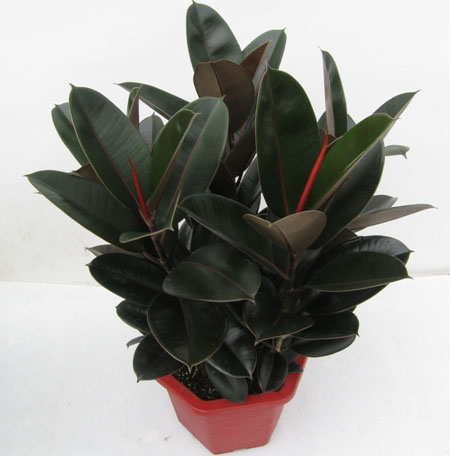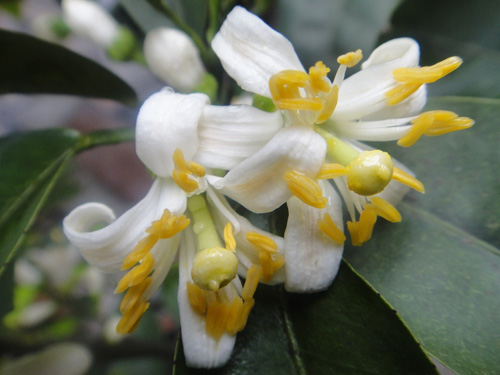What are the key points for the conservation of rubber trees (Indian rubber trees)
Rubber tree (Indian rubber tree) scientific name: ficus elastica alias: Indian rubber tree, Indian banyan big leaf green, red Burmese tree, red-billed rubber tree, Indian banyan
Families and genera: Moraceae, banyan
Distribution of origin: Indonesia, India, Malaysia.
The key point of conservation: evergreen Qiao Qiao. Potted with rotten leaf soil or peat soil. Like high temperature, high humidity and strong sunshine. During the growing period, you can move to the outdoor sun for cultivation; give sufficient water and apply liquid fertilizer once every two weeks or so. The wintering temperature is about 10 degrees Celsius. Change the basin every two years or so.
The cultivated varieties are as follows: cv.variegata and so on.
Garden application: potted plants are good materials for decorating guest halls and family rooms. In the south, they are often placed in front of buildings, in the center of flower beds and on both sides of the road. Small and medium-sized plants are often used to beautify the living room and study; medium and large plants are suitable to be arranged on both sides of the foyer of large buildings and in the center of the lobby, which is magnificent and can reflect the tropical scenery.

Propagation: cutting, high branch crimping.
Lighting: like strong light, not resistant to shade (sufficient light).
Moisture: growing in moist soil.
Temperature: slightly cold-resistant, can withstand the low temperature of-5 degrees Celsius.
Humidity: medium relative humidity, 50% to 60%.
How to raise a rubber tree? Guide for hydroponic culture and maintenance of rubber trees
Rubber trees, also known as Indian rubber trees, Indian rubber banyan and so on, are often used for pot cultivation in recent years because of their high ornamental value. Below, the editor of Huinong Network will explain the hydroponic culture methods and maintenance guidelines of rubber trees with you, and learn together.
1. Growth characteristics
Rubber tree leaves thick, oval, tip, as wide as palm, glossy, evergreen, is a world-famous foliage tree species. The tree of origin can grow to more than 30 meters, the trunk is stout, the root is rich, the branchlets are smooth, and the whole body contains milk. The buds are red, with bracts, the young leaves are dark red, and the old leaves are dark green.
2. Hydroponic culture method
The main results are as follows: (1) hydroponic rubber trees should choose small soil-cultured plants with better plant shape, and convert them into hydroponic culture by root washing. After washing, the plants are planted in a container and water is added to the 1 stroke, 3-1 beat of the root system. Glass containers with planting cups are suitable for large rubber trees.
(2) the old roots of small soil culture plants with better plant shape were selected, washed and cultured in water. Or choose the branches that grow sturdily from May to September, remove the basal leaves and dry the incisions, and then directly water-plug and breed them. Because the crown is heavy, ceramsite needs to be added to the container to fix the plant, which is conducive to rooting.
3. Maintenance guidelines
(1) temperature and light
The suitable temperature for rubber tree growth is 22 ~ 32 ℃, and the safe overwintering temperature is above 8 ℃. Rubber trees like to have enough scattered light, strong growth with sufficient light, broad and bright leaves, and weak branches with poor light. Be protected from direct sunlight in summer.
(2) changing water
The water of the hydroponic rubber tree is changed once in the first 2-3 days. After the water grows and takes root, the water can be changed every 10-15 days, and the nutrient solution is changed every two weeks.
The above is the guide on the hydroponic culture and maintenance of rubber trees compiled by Huinong net. Have you learned all about it? If you have any questions about breeding, you can comment and leave a message below.
How to cultivate rubber trees to teach you the skills of maintaining rubber trees
Rubber tree, also known as Indian banyan and Indian rubber, is an evergreen woody foliage plant of the genus Ficus of Moraceae. Rubber tree leaves are large, thick leathery, glossy, round to long oval; the leaf surface is dark green, the back of the leaf is light green, the initial cover is outside the terminal bud, the stipules fall off after the new leaves are extended, and leave stipule marks on the branches. Let's take a look at the introduction of the cultivation methods of rubber trees.
1. Basic information of rubber trees
Rubber tree is native to India and Malaysia, so it is also known as Indian rubber tree and Indian banyan. There is a lot of cultivation in all parts of China. There are about 1000 murmur2000 species of the same genus, which are widely distributed in tropical and subtropical regions of China. Rubber tree is also known as Indian banyan or Indian rubber tree. The leaves of rubber trees are bright and evergreen. They are common foliage plants and suitable for potted plants. Rubber trees are native to India and like warm and humid weather. It requires fertile soil. Like light, can also be shade-tolerant, not cold-resistant, and are vulnerable to freezing injury when the winter temperature is lower than 5 ℃. The suitable temperature is 20 ℃-25 ℃. The rubber tree is about 25 meters tall and has a breast diameter of 25 Murray 40 cm; the bark is gray-white, smooth; epiphytic when young, branchlets stout. Its ornamental variety: yellow-edged rubber tree, the leaf has a golden edge, the autumn is more obvious; the white leaf yellow-edged rubber tree, the leaf is milky white, and the edge is yellow, the leaf surface has yellow-white markings. The whole plant is smooth and hairless, and the stem is angry and rooted with latex juice. Leaves broad and long-stalked, thickly leathery, glossy, bright green, long elliptic or rectangular, apex acuminate, margin entire. Buds red, bracteate. The lateral vein is at right angle to the middle rib. When the new buds are born, the rubber tree is wrapped in reddish stipules and has a beautiful appearance. The crown of the rubber tree is spreading, with aerial roots and milk. The leaves are thick, leathery, glossy, long oval or rectangular-shaped, 15mm long and 7cm wide. Stipule solitary, light red. Inflorescences opposite in leaf axils, rectangular orbicular, yellow at maturity; male flowers, female flowers and gall peanuts in the same inflorescence receptacle.
Second, the ecological habits of rubber trees
Rubber trees like the warm, humid, sun-deficient environment, but also slightly resistant to shade, not cold. It is required that the soil be rich and loose, and grow well in neutral or acidic soil. When potted, it is appropriate to use rotten leaf soil, grass ash soil plus about 1 to 4 river sand and a large number of base fertilizer to make up the soil. Usually keep the soil moist and apply dilute liquid fertilizer every 15 murmurs every 20 days. In the summer low temperature season, the rubber tree grows faster, should be big, thin and small water, but to prevent stagnant water in the basin. After entering autumn, gradually increase fertilization and watering, rush into the plant growth emptiness, which is conducive to overwintering. Because rubber trees like the sun, they should be kept outside in the sun from spring to autumn; if left in the shade for a long time, it is easy to cause leaves to yellowing and falling off. Like the sun, single is also more shady, watering more overnight tea, the whole plant should often spray water, wipe the leaves with wet cloth, which is beneficial to photosynthesis.
Because the rubber tree is not resistant to cold, it must be moved to the sunny place outside in summer to maintain the room temperature above 10 ℃, and the minimum temperature should not be lower than 5 ℃. If the temperature is too low and the basin soil is wet, the leaves will blacken and fall off, the roots will erode, and even the whole plant will die. Move to the courtyard or balcony for maintenance from the end of April to the beginning of May next year. The south should pay attention to the change of season from indoor to outdoor can not immediately receive strong sunlight, that is, the change of light and temperature should not be too great. The room temperature is low in summer, so it should be watered in large quantities to maintain the micro-tide of the basin soil.
The leaves of rubber trees are bright, green and pleasant, and their plants are short and powerful, so they are suitable to be placed on the balcony to afforest the environment.
III. Culture methods of rubber trees
When planting rubber trees in pots, it is appropriate to use 1 part of rotten leaf soil, 1 part of garden soil and 1 part of river sand, and add a small amount of base fertilizer to form culture soil. It grows very fast in a hot and humid environment, and a leaf can be produced every 5 Murray for 10 days. During this period, adequate fertilizer and moisture must be guaranteed. Generally, liquid fertilizer or compound fertilizer is applied twice a month to maintain high soil moisture. After autumn, gradually reduce the number of fertilization and watering, in order to promote plant growth and enrichment, conducive to overwintering.
Rubber trees like strong sunlight and should be cultivated in the sun throughout the growing season from spring to autumn and in strong light in winter, but it can also tolerate shade and is better cultivated in low light indoors. In addition, in order to make the plant grow symmetrically and ensure a good plant shape, coring was carried out when the seedlings grew to a height of 50 murmuri 80 cm, so as to promote the sprouting of lateral branches; after the lateral branches grew, 5 branches were selected, and then the lateral branches were cut once a year, and the larger plants with complete plant shape, round and plump could be obtained after 3 years.
- Prev

Culture methods of generations of flowers
Generation (citrusaurantium) alias: Dai Dai, generation fruit, generation flower, stinky orange, lime, green orange family: Rutaceae, citrus morphological characteristics: evergreen shrub. Branches sparsely short spines, twigs angular. The trunk bark is green with volatile oil glands. Leaves alternate, leathery
- Next

What is thyme? the culture method of thyme
Thyme scientific name: thymusvulgaris alias: thyme, ground pepper, ground pepper, mountain pepper, family and genus: Labiatae, thyme. Morphological characteristics: the plant is about 20 cm tall and the whole plant has aroma and mild spicy taste. The lower part of the stem is creeping and tufted, the upper part is erect, quadrangular.
Related
- Fuxing push coffee new agricultural production and marketing class: lack of small-scale processing plants
- Jujube rice field leisure farm deep ploughing Yilan for five years to create a space for organic food and play
- Nongyu Farm-A trial of organic papaya for brave women with advanced technology
- Four points for attention in the prevention and control of diseases and insect pests of edible fungi
- How to add nutrient solution to Edible Fungi
- Is there any good way to control edible fungus mites?
- Open Inoculation Technology of Edible Fungi
- Is there any clever way to use fertilizer for edible fungus in winter?
- What agents are used to kill the pathogens of edible fungi in the mushroom shed?
- Rapid drying of Edible Fungi

